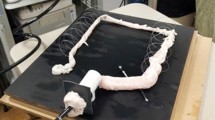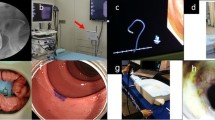Abstract
Background
Colonic endoscopic submucosal dissection (ESD) has developed in recent years to permit en bloc resection of larger colorectal lesions that cannot be done by standard polypectomy or mucosal resection techniques. Colonic ESD is technically demanding and has a steep learning curve. Adequate training is essential to make ESD a reliable treatment for colorectal neoplasms. We aim to share our early experience with an in vitro porcine training model for colonic ESD.
Method
Resected porcine distal colon was used to set up a training model for ESD, which was performed as in human using a standard endoscope and dissecting devices. Size of the lesions, operation time, en bloc resection rate, and perforation rate were recorded.
Results
Ten consecutive colonic ESD procedures were performed by a single endoscopist. Incomplete resection and perforation were encountered during the first two procedures. No perforation occurred in subsequent procedures and the operation time per task also decreased gradually. The setup cost for this model was only around US $30.
Conclusions
The in vitro porcine model is easy and inexpensive to set up. Our initial experience showed that the model could simulate colonic ESD in human and technical proficiency improved by repetition. This simple setup may be a promising training model for endoscopists working in areas with a low incidence of early gastric cancer.




Similar content being viewed by others
References
Hurlstone DP, Fujii T, Lobo AJ (2002) Early detection of colorectal cancer using high magnification chromoscopic colonoscopy. Br J Surg 89:272–282
Hurlstone DP, Cross SS, Adam I, Shorthouse AJ, Brown S, Sanders DS, Lobo AJ (2004) Efficacy of high magnification chromoscopic colonoscopy for the diagnosis of neoplasia in flat and depressed lesions of the colorectum: a prospective analysis. Gut 53:284–290
Rex DK (2007) Have we defined best colonoscopic polypectomy practice in the United States? Clin Gastroenterol Hepatol 5:674–677
Kudo S (1993) Endoscopic mucosal resection of flat and depressed types of early colorectal cancer. Endoscopy 25:455–461
Saitoh Y, Fujiya M, Watari J (2008) Endoscopic mucosal resection and endoscopic piecemeal mucosal resection for colorectal neoplasia. In: Niwa H (ed) New challenges in gastrointestinal endoscopy. Springer, Tokyo, pp 346–352
Arebi N, Swain D, Suzuki N, Fraser C, Price A, Saunders BP (2007) Endoscopic mucosal resection of 161 large sessile or flat colorectal polyps. Scand J Gastroenterol 42:859–866
Kaltenbach T, Friedland S, Maheshwari A, Ouyang D, Rouse RV, Wren S, Soetikno R (2007) Short- and long-term outcomes of standardized EMR of nonpolypoid (flat and depressed) colorectal lesions > or = 1 cm. Gastrointest Endosc 65:857–865
Gotoda T, Yamamoto H, Soetikno RM (2006) Endoscopic submucosal dissection of early gastric cancer. J Gastroenterol 41:929–942
Ono H, Kondo H, Gotoda T, Shirao K, Yamaguchi H, Saito D, Hosokawa K, Shimoda T, Yoshida S (2001) Endoscopic mucosal resection for treatment of early gastric cancer. Gut 48:225–229
Fujishiro M, Yahagi N, Kakushima N, Kodashima S, Muraki Y, Ono S, Yamamichi N, Tateishi A, Oka M, Ogura K, Kawabe T, Ichinose M, Omata M (2007) Outcomes of endoscopic submucosal dissection for colorectal epithelial neoplasms in 200 consecutive cases. Clin Gastroenterol Hepatol 5:678–683
Saito Y, Uraoka T, Matsuda T, Emura F, Ikehara H, Mashimo Y, Kikuchi T, Fu KI, Sano Y, Saito D (2007) Endoscopic treatment of large superficial colorectal tumors: a case series of 200 endoscopic submucosal dissections. Gastrointest Endosc 66:966–973
Saito Y, Fukuzawa M, Matsuda T, Fukunaga S, Sakamoto T, Uraoka T, Nakajima T, Ikehara H, Fu KI, Itoi T, Fujii T (2010) Clinical outcome of endoscopic submucosal dissection versus endoscopic mucosal resection of large colorectal tumors as determined by curative resection. Surg Endosc 24(2):343–352
Tamegai Y, Saito Y, Masaki N, Hinohara C, Oshima T, Kogure E, Liu Y, Uemura N, Saito K (2007) Endoscopic submucosal dissection: a safe technique for colorectal tumors. Endoscopy 39:418–422
Bourke M (2009) Current status of colonic endoscopic mucosal resection in the West and the interface with endoscopic submucosal dissection. Dig Endosc 21:S22–S27
Tanaka S, Oka S, Kaneko I, Hirata M, Mouri R, Kanao H, Yoshida S, Chayama K (2007) Endoscopic submucosal dissection for colorectal neoplasia: possibility of standardization. Gastrointest Endosc 66:100–107
Taku K, Sano Y, Fu KI, Saito Y, Matsuda T, Uraoka T, Yoshino T, Yamaguchi Y, Fujita M, Hattori S, Ishikawa T, Saito D, Fujii T, Kaneko E, Yoshida S (2007) Iatrogenic perforation associated with therapeutic colonoscopy: a multicenter study in Japan. J Gastroenterol Hepatol 22:1409–1414
Yoshida N, Wakabayashi N, Kanemasa K, Sumida Y, Hasegawa D, Inoue K, Morimoto Y, Kashiwa A, Konishi H, Yagi N, Naito Y, Yanagisawa A, Yoshikawa T (2009) Endoscopic submucosal dissection for colorectal tumors: technical difficulties and rate of perforation. Endoscopy 41:758–761
Yahagi N, Neuhaus H, Schumacher B, Neugebauer A, Kaehler GF, Schenk M, Fischer K, Fujishiro M, Enderle MD (2009) Comparison of standard endoscopic submucosal dissection (ESD) versus an optimized ESD technique for the colon: an animal study. Endoscopy 41:340–345
Yamamoto H (2007) Technology insight: endoscopic submucosal dissection of gastrointestinal neoplasms. Nat Clin Pract Gastroenterol Hepatol 4:511–520
Acknowledgment
We thank Dr. Y. Saito of the National Cancer Center of Japan for allowing us to adopt and modify their animal model for ESD training.
Disclosures
Drs. Hon, Ng, Lee, Li, and Lo have no conflicts of interest or financial ties to disclose.
Author information
Authors and Affiliations
Corresponding author
Rights and permissions
About this article
Cite this article
Hon, S.S.F., Ng, S.S.M., Lee, J.F.Y. et al. In vitro porcine training model for colonic endoscopic submucosal dissection: an inexpensive and safe way to acquire a complex endoscopic technique. Surg Endosc 24, 2439–2443 (2010). https://doi.org/10.1007/s00464-010-0982-5
Received:
Accepted:
Published:
Issue Date:
DOI: https://doi.org/10.1007/s00464-010-0982-5




